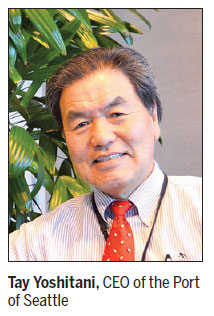Seattle port tied to growth in China
Updated: 2013-03-15 12:00
By Deng Yu in Seattle (China Daily)
|
||||||||

Almost 30 years ago, a cargo ship flying the flag of the People's Republic of China entered the Port of Seattle harbor. The 637-foot, Norwegian-built M.V. Liu Lin Hai carried no cargo, but it arrived laden with symbolism. It was the first time a Chinese cargo ship had entered a US port in 30 years and was the start of Sino-US trade.
The ship, owned by China Ocean Shipping Company (COSCO), which has since become one of the port's leading customers, left Seattle for China with 37,000 metric tons of corn from the Midwest.
In his office with a water-front view of the Puget Sound that wends its way north to the Pacific Ocean, Tay Yoshitani, CEO of the Port of Seattle, said China's growth is tied to the port's growth. "We need strong economies on both sides of the Pacific to maintain jobs and prosperity in our respective countries. We seek many ways of strengthening those ties."
Yoshitani arrived at the port in 1954 with his family from Japan when he was 7 years old, and never did he expect that he would manage the port more than a half a century later. Now he oversees 1,700 employees and all the port's programs.
Before becoming CEO of the port in March 2007, Yoshitani served as senior adviser to the National Association of Waterfront Employers, and was executive director for the Port of Oakland, California, the Maryland Port Administration and the Port of Los Angeles.
Founded in 1911, the Port of Seattle was the state's first public port and is the 6th largest container port in the US. It owns and operates Seattle-Tacoma International Airport, four container cargo terminals, two cruise-ship terminals, four public marinas and a grain terminal, and manages a number of real estate assets.
The Seattle-Tacoma International Airport had more than 32.8 million passengers in 2011. The port's passenger cruise terminals handled 195 ship calls and about 800,000 passengers in 2011. Seattle's seaport and airport generate nearly 200,000 jobs throughout the region with a payroll in excess of $6.8 billion.
Since the 1990s Yoshitani has visited China at least two times each year for business.
Though he doesn't speak Chinese, Yoshitani said the port has employees who do, and who "understand China very well. They help communicate efficiently with our business partners in China".
China was No 1 for Washington State's exports in 2012. The state posted $14.2 billion in exports to China, or 18.8 percent of its total of $75.5 billion, according to the US Department of Commerce's International Trade Administration.
The state's largest export category is transportation equipment, which accounted for $38.2 billion of Washington's total exports in 2012. Other top exports are agricultural products ($12.0 billion), petroleum and coal products ($3.8 billion), computer and electronic products ($3.7 billion), and food and kindred products ($3.3 billion).
The port's relationship with China isn't limited to importing and exporting. "Our cranes are the best in the world, manufactured by Shanghai Zhenhua Heavy Industries Company Limited of China," Yoshitani said.
In a report released on its 100th anniversary in 2011, the port set a goal of adding 100,000 jobs while becoming the nation's most environmentally "green" and energy-efficient port. "We will also grow our region as a premier international logistics hub," Yoshitani said.
lindadeng@chinadailyusa.com
(China Daily 03/15/2013 page11)

 In Photos: 7.0-magnitude quake hits Sichuan
In Photos: 7.0-magnitude quake hits Sichuan
 Li Na on Time cover, makes influential 100 list
Li Na on Time cover, makes influential 100 list
 FBI releases photos of 2 Boston bombings suspects
FBI releases photos of 2 Boston bombings suspects
 World's wackiest hairstyles
World's wackiest hairstyles
 Sandstorms strike Northwest China
Sandstorms strike Northwest China
 Never-seen photos of Madonna on display
Never-seen photos of Madonna on display
 H7N9 outbreak linked to waterfowl migration
H7N9 outbreak linked to waterfowl migration
 Dozens feared dead in Texas plant blast
Dozens feared dead in Texas plant blast
Most Viewed
Editor's Picks

|

|

|

|

|

|
Today's Top News
Live report: 7.0-magnitude quake hits Sichuan, heavy casualties feared
Boston suspect cornered on boat
Cross-talk artist helps to spread the word
'Green' awareness levels drop in Beijing
Palace Museum spruces up
First couple on Time's list of most influential
H7N9 flu transmission studied
Trading channels 'need to broaden'
US Weekly

|

|







